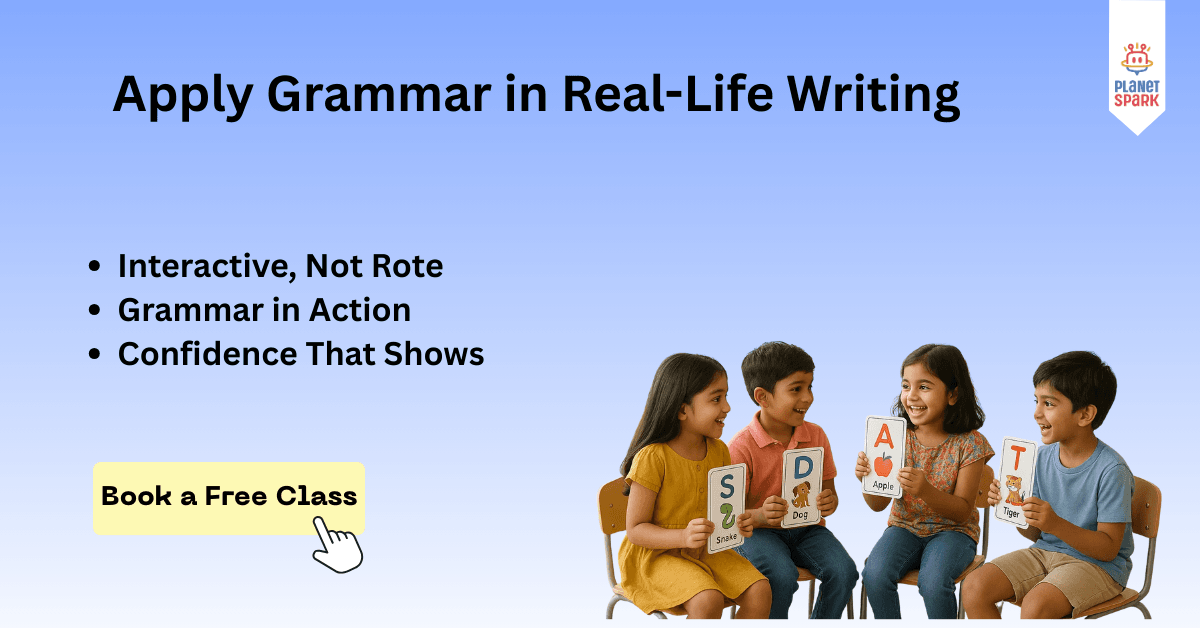Gerund – Definition, Meaning, Examples, and Usage for Kids

Table of Contents
- What is a Gerund? (Gerund Definition)
- How to Identify a Gerund
- Gerund Examples in Sentences
- Gerunds vs Present Participles
- More Gerund Examples for Kids
- How Gerunds are Used in Sentences
- Gerunds After Certain Verbs
- Gerunds After Prepositions
- Gerund Phrase
- Gerund and Infinitive – What’s the Difference?
- Common Mistakes with Gerunds
- Worksheet: Identify the Gerunds
- Why Gerunds Are Important
- How to Teach Gerunds to Kids
- Practice Sentences for Kids
- Fun Gerund Quiz
- Learn English Grammar with PlanetSpark
- Frequently Asked Questions
When learning English grammar, you might have come across words that look like verbs but act like nouns. These special words are called gerunds. Understanding gerunds is important because they appear everywhere—in reading, writing, and speaking. Let’s explore what a gerund is, how to use it correctly, and how it is different from similar grammar forms like participles and infinitives.
What is a Gerund? (Gerund Definition)
A gerund is a verb + ing form that works as a noun in a sentence.
It is formed by adding -ing to a verb, but instead of showing an action, it names the action.
Gerund Meaning for Kids
Think of a gerund as a word that talks about an action as a thing or idea, not something happening right now.
For example:
Swimming is fun.
Here, swimming is a gerund because it names the activity you enjoy. It doesn’t show someone swimming; it names the activity itself.
So, whenever you add -ing to a verb and it acts like a noun, you’ve found a gerund.

How to Identify a Gerund
To find a gerund in a sentence, ask this simple question:
“Is this word naming an activity or thing?”
If yes, it’s a gerund.
Here’s a quick trick:
Gerunds can be the subject of a sentence.
Gerunds can be the object of a verb or preposition.
Gerunds can come after certain verbs.
Let’s look at some examples.
Gerund Examples in Sentences
| Sentence | Gerund | Function |
|---|---|---|
| Reading helps you learn new things. | Reading | Subject |
| I enjoy painting in my free time. | Painting | Object of verb |
| She is good at singing. | Singing | Object of preposition |
| Playing with friends makes me happy. | Playing | Subject |
| We talked about going on vacation. | Going | Object of preposition |
As you can see, reading, painting, singing, playing, and going are all gerunds because they describe an activity or idea, not an action being performed right now.
Book a free demo class at PlanetSpark to learn English grammar interactively.
Gerunds vs Present Participles
Now that you know what a gerund is, let’s clear a common confusion, the difference between a gerund and a present participle.
Both look similar because both use verb + ing, but they play different roles in a sentence.
Difference Between Gerund and Participle
| Gerund | Present Participle |
|---|---|
| Acts as a noun | Acts as an adjective |
| Reading is my hobby. | The reading boy is my brother. |
| Swimming is good exercise. | The swimming fish looked colorful. |
So, when the -ing word works as a noun, it’s a gerund. When it describes something, it’s a participle.
More Gerund Examples for Kids
Here are some simple sentences showing gerunds in everyday use:
Cooking is my mother’s favorite hobby.
My brother loves running in the park.
Drawing helps me relax.
Laughing makes everyone happy.
Learning English is fun with stories and games.
Watching cartoons is my favorite activity.
Sleeping early keeps me fresh.
I enjoy listening to music.
Writing in a diary helps me remember my day.
Dancing improves fitness and mood.
Notice how each sentence uses a verb + ing form as a noun. That’s what makes it a gerund.
How Gerunds are Used in Sentences
Gerunds can play different roles in a sentence. Let’s explore them one by one.
1. Gerund as the Subject
A gerund can be the subject of a sentence.
Example:
Playing football is exciting.
Reading improves knowledge.
2. Gerund as the Object
Sometimes, a gerund follows an action verb and becomes the object.
Example:
She enjoys singing.
They like traveling.
3. Gerund as the Object of a Preposition
When a gerund comes after a preposition, it acts as the object of that preposition.
Example:
She is interested in drawing.
He talked about learning French.
4. Gerund as a Subject Complement
A gerund can rename or describe the subject.
Example:
My favorite hobby is reading.
Her passion is painting.
Gerunds After Certain Verbs
Some verbs are always followed by a gerund, not an infinitive.
Here are some examples of verbs followed by gerunds:
| Verb | Example |
|---|---|
| enjoy | I enjoy reading books. |
| admit | She admitted cheating on the test. |
| avoid | They avoid talking too much. |
| dislike | He dislikes waiting in long lines. |
| finish | We finished eating dinner. |
| keep | Keep trying until you succeed. |
| practice | She practices dancing every day. |

Gerunds After Prepositions
A gerund often follows a preposition like in, on, about, of, at, or without.
Examples:
He is afraid of failing.
She is good at writing stories.
They left without saying goodbye.
He talked about joining the club.
Whenever you see a preposition, the next word is usually a gerund, not an infinitive.
Gerund Phrase
A gerund phrase includes the gerund and any other words that describe or complete its meaning.
Example:
Eating ice cream on a hot day is refreshing.
Watching movies with friends is enjoyable.
Each phrase starts with a gerund and includes additional information, but the whole phrase acts as a noun.
Join PlanetSpark to master grammar concepts like gerunds through real-world examples.
Gerund and Infinitive – What’s the Difference?
Both gerunds and infinitives can act as nouns, but they look different.
| Gerund | Infinitive |
|---|---|
| Verb + ing | to + verb |
| I like swimming. | I like to swim. |
| She prefers reading. | She prefers to read. |
In many cases, both can work, but the meaning can slightly change. For example:
I stopped smoking. (I quit the habit.)
I stopped to smoke. (I stopped what I was doing to smoke.)
So, context matters when choosing between a gerund and an infinitive.
Common Mistakes with Gerunds
Kids often make small errors when using gerunds. Let’s fix them!
| Incorrect | Correct | Why |
|---|---|---|
| I am good in singing. | I am good at singing. | Use at before a gerund. |
| She enjoys to dance. | She enjoys dancing. | Some verbs take gerunds, not infinitives. |
| He is interested to learn. | He is interested in learning. | Use in before a gerund. |
Worksheet: Identify the Gerunds
Try this small exercise!
Find the gerund in each sentence.
Playing outside keeps kids healthy.
We discussed moving to a new city.
Reading stories helps with imagination.
She avoided talking during class.
Learning grammar is fun with PlanetSpark.
Answers:
Playing
Moving
Reading
Talking
Learning
Book a free demo class at PlanetSpark to learn English grammar interactively.
Why Gerunds Are Important
Gerunds make your writing and speaking more natural. Instead of repeating verbs or long sentences, you can use gerunds to make your thoughts clear and simple.
Examples of Why Gerunds Help
Instead of saying: “I like when I swim.”
Say: “I like swimming.”Instead of: “He enjoys when he runs.”
Say: “He enjoys running.”
Gerunds make English smoother, shorter, and more interesting.
How to Teach Gerunds to Kids
At PlanetSpark and similar creative learning platforms, kids learn grammar through storytelling, games, and real-life examples. For example:
Teachers create fun “Verb to Gerund” activities.
Kids practice identifying gerunds in stories.
Worksheets make the learning interactive and easy to remember.
This playful approach helps children remember that grammar isn’t boring, it’s part of everyday life!
Practice Sentences for Kids
Fill in the blanks with the correct gerund form of the verbs in brackets.
________ (Read) books improves knowledge.
She is interested in ________ (paint).
He avoids ________ (eat) junk food.
________ (Swim) is good exercise.
They finished ________ (play) basketball.
Answers:
Reading
Painting
Eating
Swimming
Playing
Fun Gerund Quiz
Pick the correct option:
Which of these is a gerund?
a) Jump
b) Jumping
c) Jumped
Answer: b) JumpingWhich sentence contains a gerund?
a) He is swimming.
b) Swimming is fun.
Answer: b) Swimming is fun.Gerunds always end with?
a) -ed
b) -ing
c) -s
Answer: b) -ing

Learn English Grammar with PlanetSpark
At PlanetSpark, grammar becomes fun and easy. Kids learn about gerunds, participles, adjectives, and tenses through live classes, games, and storytelling.
Features of PlanetSpark Grammar Learning:
Live interactive grammar sessions
Engaging worksheets and storytelling
Real-life examples for better understanding
Personalized teacher feedback
Learning grammar concepts like gerunds becomes exciting and practical when taught the PlanetSpark way.
Gerunds are an important part of English grammar. They help describe activities, express hobbies, and make sentences more natural. Remember, whenever you see a verb + ing that acts like a noun, that’s a gerund.
Keep practicing with examples, games, and worksheets to master gerunds easily. The more you use them, the better your English will sound.
If you want to learn grammar the fun way, explore courses where grammar meets creativity and confidence.
Join PlanetSpark to master grammar concepts like gerunds through real-world examples.
Frequently Asked Questions
Q1. What is a gerund in simple words?
A gerund is a verb + ing that acts as a noun, like reading or swimming.
Q2. Give 5 examples of gerunds.
Reading, writing, playing, dancing, singing.
Q3. What is the difference between a gerund and a participle?
A gerund works as a noun; a participle works as an adjective.
Q4. Can gerunds be plural?
No, gerunds act like nouns but don’t have plural forms.
Q5. What comes after a preposition—a gerund or an infinitive?
A gerund always comes after a preposition.
Download Free Worksheets
Personalized Communication Report
Record a video to get a AI generated personalized communication report for your child

Hi There, want to try these
tips for your child with
LIVE with our expert coach?
Let's check your child's
English fluency

